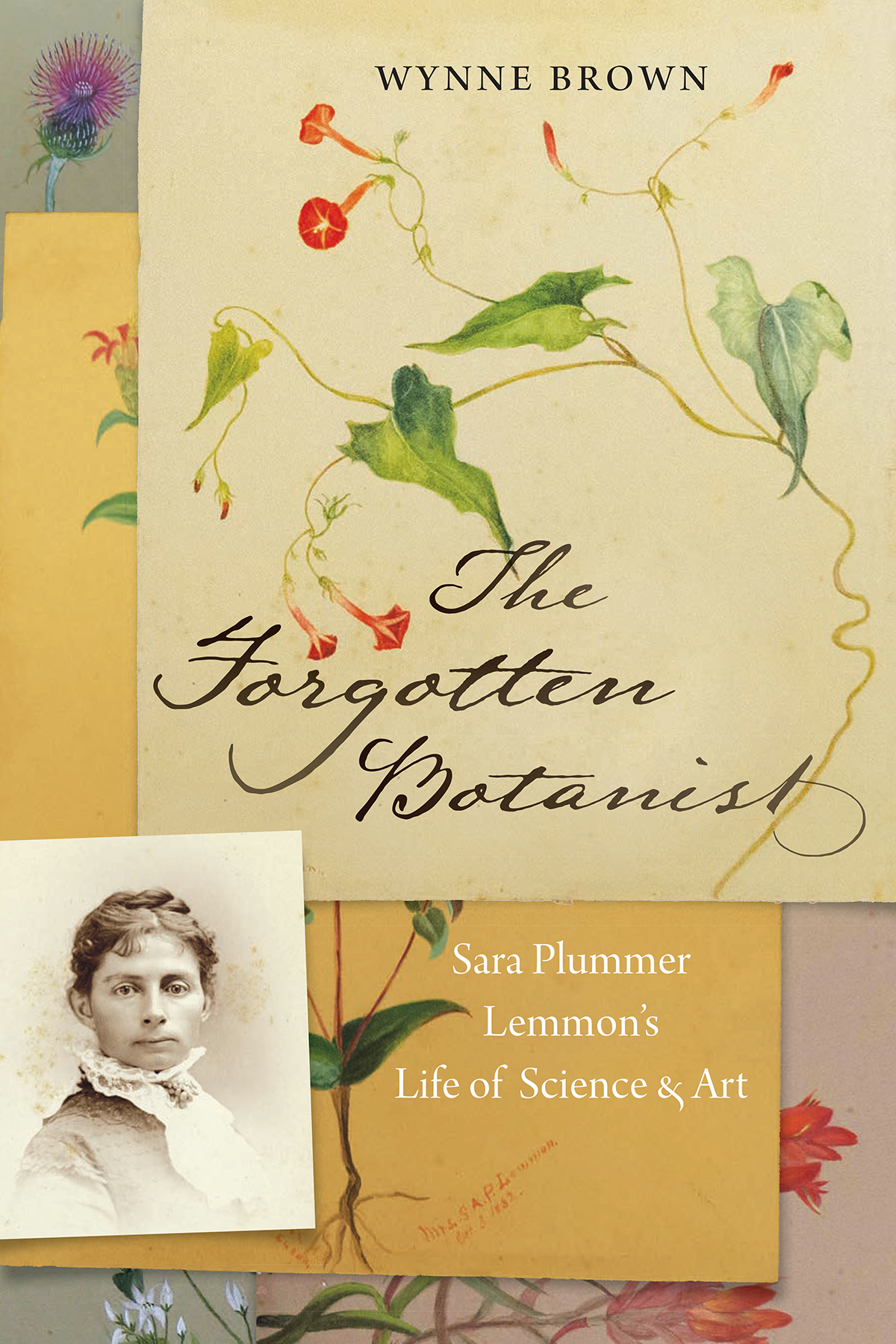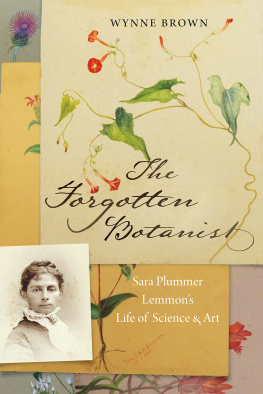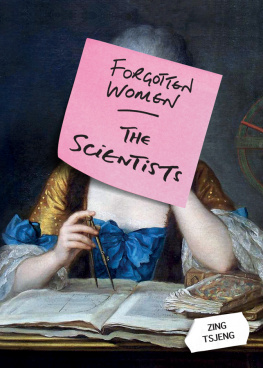
The history of botany is filled with intrepid, brilliant women, but few have gotten their due. Wynne Brown has written a lively life of Sara Plummer Lemmon, a brave nineteenth-century botanist who explored the West. She earned the admiration of the great botanists of her day, and she deserves ours as well.
Victoria Johnson, author of American Eden
In this long overdue biography of Sara Lemmon, Wynne Brown restores an overlooked luminary of the Southwest to her proper place in history. Brimming with narrative verve and a naturalists eye for detail, The Forgotten Botanist is a vivid account of how one woman overcame great odds to help shape western botany.
Francisco Cant, author of The Line Becomes the River
A stirring and intimate portrait of an unconventional, resourceful, and adventurous transplant to the American West.
Susan Cummins Miller, editor of A Sweet, Separate Intimacy

The Forgotten Botanist
Sara Plummer Lemmons Life of Science and Art
Wynne Brown
University of Nebraska Press | Lincoln
2021 by Wynne Brown
Cover designed by University of Nebraska Press; cover images are from the interior.
Author photo Pam Golden.
All rights reserved
Library of Congress Cataloging-in-Publication Data
Names: Brown, Wynne L., author.
Title: The forgotten botanist: Sara Plummer Lemmons life of science and art / Wynne Brown.
Description: Lincoln: University of Nebraska Press, [2021] | Includes bibliographical references.
Identifiers: LCCN 2021008843
ISBN 9781496222817 (paperback)
ISBN 9781496229465 (epub)
ISBN 9781496229472 (pdf)
Subjects: LCSH : Lemmon, Sara Allen Plummer, 18361923. | Women botanistsUnited StatesBiography. | Botanical illustration.
Classification: LCC QK 31. L 455 B 76 2021 | DDC 580.92 [B]dc23
LC record available at https://lccn.loc.gov/2021008843
The publisher does not have any control over and does not assume any responsibility for author or third-party websites or their content.
To all the hidden women of science
whose stories have not yet been told
Contents
People often ask me, Why do you care so much about Sara Lemmon?
During the seven years work on this project, Ive wondered the same thing. Heres one answer. Ive always been fascinated by that shaded area within a Venn diagram, the place where seemingly disparate disciplines swirl and minglelike the pouring of cream into iced coffee. Saras ferocious curiosity led her to some of those blends: science versus art, wilderness versus safety, the comforts of tradition versus the kick of questioning the status quo. Her curiosity, tenacity, and grit carried her farther than the Arizona Territorywhere a mountain would be named for herand deep into the territory of the unexpected.
I also admire her courage. In the twenty-first century, many of us mull reinventing ourselves. But moving from one coast to the other in the nineteenth century meant not seeingor even hearing the voices ofyour loved ones for five or six years. That takes more than reinvention.
It takes guts.
Sara was also immensely talented. Her few surviving watercolors are more than scientifically accurate renditions of the species: Theyre truly exquisite.
How could I not care about someone so intriguing?
In the early 2000s, while researching other remarkable pioneer women, I learned that the University of California and Jepson Herbaria Archives had six linear feet of field notes, correspondence, photographs, and artwork by Sara and John Lemmon. As someone whos worked as a journalist and a scientific researcher and illustrator, I itched to see that material. Several years later, when I finally saw the stacks of folders containing Saras handwritten letters and a tiny sample of her watercolors, I immediately knew they were a treasureand that I lacked the historical training to know what to do with it.
When in doubt, capture.
So I made three trips to Berkeley from Arizona and photographed all twelve hundred pages of her letters. Over the next three years, I read every one of them.
Its no surprise that Sara Lemmon was a member of the California Press Women: She was a born reporter. Her voice is strong and consistent and lush with narrative detailswhether she was describing the placid Mojave Indians, the scurrying of the overworked and underpaid copy girls at the New York Independent, the cool thickness of Santa Barbaras adobe walls, the sweat dripping off mens bare chests in Tombstones mines, the vital need for conserving Californias forests, the stars peeping through the silver fir branches in Kings Canyon, or how to cook lunch on a scrap of sheet metal in Baja California.
John Gill Lemmon, Saras husband, is still known to his descendants as JG, so Ive used that name as well. He too was an engaging and prolific writer. When Saras letters were missing, Ive used some of his writing to fill the gaps, while remembering he could be given to not letting the facts get in the way of a better story.
This book includes many excerpts of Saras letters. To avoid inflicting my voice on hers, Ive made very few changes, other than punctuation and updated spelling for clarity and easier reading. A warning: Some of her descriptions and attitudes are disturbing to our modern sensibilities. Sometimes she comes across as colonialist and extractive at best, and even downright racist at worst. Ive had to remind myself to read her words while remembering the contextand the fears, however unfoundedof the times. I hope readers will do the same.
Sara Allen Plummer Lemmons story is a window into one womans early West. Losing both that narrative and her artistic legacy would be a tragedy.
How could I not care about her?
New York Harbor, December 1869
Icy bits of sleet peppered Saras face and caught in the curls of her auburn hair. She tried turning her shoulder into the fierce December wind that buffeted her coat against her legs, to no availand still she waved, waved until her arm ached, and kept waving, long after the figures of her sister and her father were too tiny to discern among the crowd of well-wishers on the harbor dock.
The wooden side-wheel steamer SS Alaska churned slowly through the steel-gray waters off Manhattan, away from Brooklyn where Sara had graduated from Greenleaf Female Institute with a teaching certificate, away from the Cooper Union Institute where shed worked hard to earn degrees in physics and chemistry, away from the New England coast where shed spent her childhood, away from Bellevue Hospital where shed nursed so many Civil War soldiers, away from a myriad of friends, away from all the students whod learned to paint thanks to the art lessons she provided.
Away from her loving, supportive family: her three brothers but especially her father and Mattie, her only sister. Away from a man who worshiped her and called her my beloved. Away from everything and everyone shed ever knownleaving it all behind.
Sara remained on the deck, shivering in the wind, long after every other passenger had retreated below.
After years of juggling her teaching, night classes, and volunteer nursing work, she thought she knew about being tired. But right now she was exhausted beyond any fatigue shed ever known. She was tired of being sick, tired of packing, tired of saying goodbye, tired of trying to convince loved ones her very survival depended on starting a whole new lifea life that had to be an entire continent away. A life in exile from the contented busy life she had relished in New York City.
Next page












